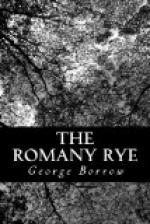Hungarian. Because the water is said to make people handsome, and above all, to restore to the aged the beauty of their youth. Well! Tekeli was my countryman, and I have the honour of having some of the blood of the Tekelis in my veins, but with respect to the queen, pardon me if I tell you that she was not an Hungarian; she was a Pole—Ersebet by name, daughter of Wladislaus Locticus King of Poland; she was the fourth spouse of Caroly the Second, King of the Magyar country, who married her in 1320. She was a great woman and celebrated politician, though at present chiefly known by her water.
Myself. How came she to invent it?
Hungarian. If her own account may be believed, she did not invent it. After her death, as I have read in Florentius of Buda, there was found a statement of the manner in which she came by it, written in her own hand, on a fly-leaf of her breviary, to the following effect:- Being afflicted with a grievous disorder at the age of seventy-two, she received the medicine which was called her water, from an old hermit whom she never saw before or afterwards; it not only cured her, but restored to her all her former beauty, so that the King of Poland fell in love with her, and made her an offer of marriage, which she refused for the glory of God, from whose holy angel she believed she had received the water. The receipt for making it and directions for using it, were also found on the fly-leaf. The principal component parts were burnt wine and rosemary, passed through an alembic; a drachm of it was to be taken once a week, “etelbenn vagy italbann,” in the food or the drink, early in the morning, and the cheeks were to be moistened with it every day. The effects according to the statement, were wonderful--and perhaps they were upon the queen; but whether the water has been equally efficacious on other people, is a point which I cannot determine. I should wish to see some old woman who has been restored to youthful beauty by the use of L’eau de la Reine d’Hongrie.
Myself. Perhaps, if you did, the old gentlewoman would hardly be so ingenuous as the queen. But who are the Hungarians—descendants of Attila and his people?
The Hungarian shook his head, and gave me to understand that he did not believe that his nation were the descendants of Attila and his people, though he acknowledged that they were probably of the same race. Attila and his armies, he said, came and disappeared in a very mysterious manner, and that nothing could be said with positiveness about them; that the people now known as Magyars first made their appearance in Muscovy in the year 884, under the leadership of Almus, called so from Alom, which, in the Hungarian language, signifies a dream; his mother, before his birth, having dreamt that the child with which she was enceinte would be the father of a long succession of kings, which, in fact, was the case; that after beating the Russians he entered Hungary, and coming to a place called Ungvar,




